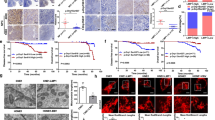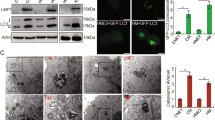Abstract
Epstein-Barr virus (EBV)-encoded BARF1 (BamH1-A Rightward Frame-1) is expressed in EBV-positive malignancies such as nasopharyngeal carcinoma, EBV-associated gastric cancer, B-cell lymphoma and nasal NK/T-cell lymphoma, and has been shown to have an important role in oncogenesis. However, the mechanism by which BARF1 elicits its biological effects is unclear. We investigated the effects of BARF1 silencing on cell proliferation and apoptosis in EBV-positive malignant cells. We observed that BARF1 silencing significantly inhibits cell proliferation and induces apoptosis-mediated cell death by collapsing the mitochondrial membrane potential in AG876 and Hone-Akata cells. BARF1 knockdown up-regulates the expression of pro-apoptotic proteins and down-regulates the expression of anti-apoptotic proteins. In BARF1-down-regulated cells, the Bcl-2/BAX ratio is decreased. The caspase inhibitor z-VAD-fmk was found to rescue siBARF1-induced apoptosis in these cells. Immunoblot analysis showed significant increased levels of cleaved caspase 3 and caspase 9. We observed a significant increase in cytochrome c level as well as the formation of apoptosome complex in BARF1-silenced cells. In conclusion, siRNA-mediated BARF1 down-regulation induces caspase-dependent apoptosis via the mitochondrial pathway through modulation of Bcl-2/BAX ratio in AG876 and Hone-Akata cells. Targeting BARF1 using siRNA has the potential to be developed as a novel therapeutic strategy in the treatment of EBV-associated malignancies.





Similar content being viewed by others
References
Brunelle JK and Letai A 2009 Control of mitochondrial apoptosis by the Bcl-2 family. J Cell. Sci. 122 437–441
Chaitanya GV, Alexander JS and Babu PP 2010 PARP-1 cleavage fragments: Signatures of cell-death proteases in neurodegeneration. Cell Commun. Signal 8 31
Chang MS, Kim DH, Roh JK, Middeldorp JM, Kim YS, Kim S, Han S, Kim CW, et al. 2013 Epstein-Barr virus-encoded BARF1 promotes proliferation of gastric carcinoma cells through regulation of NF-κB. J. Virol. 87 10515–10523
Danve C, Decaussin G, Busson P and Ooka T 2001 Growth transformation of primary epithelial cells with a NPC-derived Epstein–Barr virus strain. Virology 288 223–235
De Turenne-Tessier M, Jolicoeur P, Middeldorp JM and Ooka T 2005 Expression and analysis of the Epstein-Barr virus BARF1-encoded protein from a tetracycline-regulatable adenovirus system. Virus res. 109 9–18
Decaussin G, Sbih-Lammali F, de Turenne-Tessier M, Bouguermouh A and Ooka T 2000 Expression of BARF1 gene encoded by Epstein-Barr virus in nasopharyngeal carcinoma biopsies. Cancer Res. 60 5584–5588
Fiorini S and Ooka T 2008 Secretion of Epstein-Barr virus-encoded BARF1 oncoprotein from latently infected B cells. Virol. J. 5 70
Fulda S and Debatin KM 2006 Extrinsic versus intrinsic apoptosis pathways in anticancer chemotherapy. Oncogene 25 4798–4811
Gitlin L, Karelsky S and Andino R 2002 Short interfering RNA confers intracellular antiviral immunity in human cells. Nature 418 430–434
Glaser R, Zhang HY, Yao KT, Zhu HC and Wang FX 1989 Two epithelial tumor cell lines (HNE-1 and HONE-1) latently infected with Epstein-Barr virus that were derived from nasopharyngeal carcinomas. Proc. Natl. Acad. of Sci. USA 86 9524–9528
Gottlieb E, Armour SM, Harris MH and Thompson CB 2003 Mitochondrial membrane potential regulates matrix configuration and cytochrome c release during apoptosis. Cell Death Differ. 10 709–717
Gross A, McDonnell JM and Korsmeyer SJ 1999 BCL-2 family members and the mitochondria in apoptosis. Genes Dev. 13 1899–1911
Hajra KM and Liu JR 2004 Apoptosome dysfunction in human cancer. Apoptosis Int. J. Program. Cell Death 9 691–704
Hoebe EK, Hutajulu SH, van Beek J, Stevens SJ, Paramita DK, et al. 2011 Purified hexameric Epstein-Barr virus-encoded BARF1 protein for measuring anti-BARF1 antibody responses in nasopharyngeal carcinoma patients. Clin. Vaccine Immunol. CVI 18 298–304
Hoebe EK, Le Large TYS, Tarbouriech N, Oosterhoff D, De Gruijl TD, et al. 2012a Epstein-Barr Virus-encoded BARF1 protein is a decoy receptor for macrophage colony stimulating factor and interferes with macrophage differentiation and activation. Viral Immunol. 25 461–470
Hoebe EK, Wille C, Hopmans ES, Robinson AR, Middeldorp JM, et al. 2012b Epstein-Barr virus transcription activator R up-regulates BARF1 expression by direct binding to its promoter, independent of methylation. J. Virol. 86 11322–11332
Houali K, Wang X, Shimizu Y, Djennaoui D, Nicholls J, et al. 2007 A new diagnostic marker for secreted Epstein-Barr virus–encoded LMP1 and BARF1 oncoproteins in the serum and saliva of patients with nasopharyngeal carcinoma. Clin. Cancer Res. 13 4993–5000
Jiang R, Cabras G, Sheng W, Zeng Y and Ooka T 2009 Synergism of BARF1 with Ras induces malignant transformation in primary primate epithelial cells and human nasopharyngeal epithelial cells. Neoplasia N Y N 11 964–973
Kaufmann SH, Desnoyers S, Ottaviano Y, Davidson NE and Poirier GG 1993 Specific proteolytic cleavage of Poly(ADP-Ribose) polymerase: an early marker of chemotherapy-induced apoptosis. Cancer Res. 53 3976–3985
Korsmeyer SJ 1999 BCL-2 gene family and the regulation of programmed cell death. Cancer Res. 59 1693s–1700s
Ledgerwood EC and Morison IM 2009 Targeting the apoptosome for cancer therapy. Clin. Cancer Res. 15 420–424
Ly JD, Grubb DR and Lawen A 2003 The mitochondrial membrane potential (deltapsi(m)) in apoptosis; an update. Apoptosis Int. J. Program. Cell Death 8 115–128
Martin SJ, Reutelingsperger CP, McGahon AJ, Rader JA, Schie RC, et al. 1995 Early redistribution of plasma membrane phosphatidylserine is a general feature of apoptosis regardless of the initiating stimulus: inhibition by overexpression of Bcl-2 and Abl. J. Exp. Med. 182 1545–1556
Oltvai ZN, Milliman CL and Korsmeyer SJ 1993 Bcl-2 heterodimerizes in vivo with a conserved homolog, Bax, that accelerates programmed cell death. Cell 74 609–619
Reed JC 1996 Balancing cell life and death: bax, apoptosis, and breast cancer. J. Clin. Invest. 97 2403–2404
Sakka E, Zur Hausen A, Houali K, Liu H, Fiorini S, et al. 2013 Cellular localization of BARF1 oncoprotein and its cell stimulating activity in human epithelial cell. Virus Res. 174 8–17
Sall A, Caserta S, Jolicoeur P, Franqueville L, de Turenne-Tessier M, et al. 2004 Mitogenic activity of Epstein-Barr virus-encoded BARF1 protein. Oncogene 23 4938–4944
Seto E, Yang L, Middeldorp J, Sheen TS, Chen JY, et al. 2005 Epstein–Barr Virus (EBV)-encoded BARF1 gene is expressed in nasopharyngeal carcinoma and EBV-associated gastric carcinoma tissues in the absence of lytic gene expression. J Med. Virol. 76 82–88
Seto E, Ooka T, Middeldorp J and Takada K 2008 Reconstitution of nasopharyngeal carcinoma-type EBV infection induces tumorigenicity. Cancer Res. 68 1030–1036
Sheng W, Decaussin G, Sumner S and Ooka T 2001 N-terminal domain of BARF1 gene encoded by Epstein-Barr virus is essential for malignant transformation of rodent fibroblasts and activation of BCL-2. Oncogene 20 1176–1185
Sheng W, Decaussin G, Ligout A, Takada K and Ooka T 2003 Malignant transformation of Epstein-Barr virus-negative Akata cells by introduction of the BARF1 gene carried by Epstein-Barr virus. J. Virol. 77 3859–3865
Tanner JE, Wei MX, Alfieri C, Ahmad A, Taylor P, et al. 1997 Antibody and antibody-dependent cellular cytotoxicity responses against the BamHI A Rightward Open-Reading Frame-1 Protein of Epstein-Barr virus (EBV) in EBV-associated disorders. J. Infect. Dis. 175 38–46
Wang Q, Tsao SW, Ooka T, Nicholls JM, Cheung HW, et al. 2006 Anti-apoptotic role of BARF1 in gastric cancer cells. Cancer Lett. 238 90–103
Wei MX, Turenne-Tessier M, Decaussin G, Benet G and Ooka T 1997 Establishment of a monkey kidney epithelial cell line with the BARF1 open reading frame from Epstein-Barr virus. Oncogene 14 3073–3081
Wei MX and Ooka T 1989 A transforming function of the BARF1 gene encoded by Epstein-Barr virus. EMBO J. 8 2897–2903
Wei MX, Moulin JC, Decaussin G, Berger F and Ooka T 1994 Expression and tumorigenicity of the Epstein-Barr virus BARF1 gene in human Louckes B-lymphocyte cell line. Cancer Res. 54 1843–1848
Xue S, Labrecque LG, Lu QL, Ong SK, Lampert IA, et al. 2002 Promiscuous expression of Epstein-Barr virus genes in Burkitt’s lymphoma from the central African country Malawi. Int. J. Cancer 99 635–643
Zhang Y, Ohyashiki JH, Takaku T, Shimizu N and Ohyashiki K 2006 Transcriptional profiling of Epstein–Barr virus (EBV) genes and host cellular genes in nasal NK/T-cell lymphoma and chronic active EBV infection. Br. J. Cancer 94 599–608
Zur Hausen A, Brink AATP, Craanen ME, Middeldorp JM, Meijer CJLM, et al. 2000 Unique transcription pattern of Epstein-Barr virus (EBV) in EBV-carrying gastric adenocarcinomas: Expression of the transforming BARF1 gene. Cancer Res. 60 2745–2748
Acknowledgements
We thank Dr Middeldorp from the Department of Pathology, VU University Medical Center, for kindly providing the BARF1 antibody. We also thank Dr Ea Chee Kwee from the Institute of Biological Sciences, University of Malaya, for providing reagents in immunoprecipitation experiment, and Mr Lim Chun Shen for figure preparation for this manuscript.
Author information
Authors and Affiliations
Corresponding author
Additional information
Corresponding editor: Seyed E Hasnain
[Mohidin TBM and Ng CC 2015 BARF1 gene silencing triggers caspase-dependent mitochondrial apoptosis in Epstein-Barr virus-positive malignant cells. J. Biosci. 40 1–11] DOI 10.1007/s12038-015-9502-z
Supplementary materials pertaining to this article are available on the Journal of Biosciences Website at http://www.ias.ac.in/jbiosci/mar2015/supp/Mohidin.pdf
Electronic supplementary material
Below is the link to the electronic supplementary material.
ESM 1
(PDF 221 kb)
Rights and permissions
About this article
Cite this article
Mohidin, T.B.M., Ng, C.C. BARF1 gene silencing triggers caspase-dependent mitochondrial apoptosis in Epstein-Barr virus-positive malignant cells. J Biosci 40, 41–51 (2015). https://doi.org/10.1007/s12038-015-9502-z
Received:
Accepted:
Published:
Issue Date:
DOI: https://doi.org/10.1007/s12038-015-9502-z




